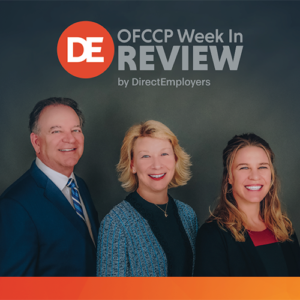Tuesay, March 19, 2019: Pay Data Update by April 3rd

Judge Chutkan then ruled on March 19 that the federal government advise the Court not later than April 3, 2019 about its plans to require employer reporting, possibly before May 31, 2019 (the currently scheduled close of the EEO-1 reporting cycle).
Thursday, March 21, 2019: Major Appeals Court Ruling Defines Who is “Similarly Situated” and Holds that Plaintiff Must Prove It Early in an Investigation and Before Trial
Holding # 1: A plaintiff must FIRST prove that the employees (or Applicants) allegedly comparable are in fact “similarly situated in all material respects”).
Impact: This holding would apply by extension to agencies like the EEOC or OFCCP prosecuting a claim on behalf of an Applicant or employee or on behalf of the federal Government (as OFCCP does). Guesses, assumptions and mere unsupported assertions do not count. Otherwise: full stop. An agency investigation may not progress, and a case in the courts may not proceed to trial.
Holding # 2: “Similarly situated employees” are those who are “similarly situated in all material respects.”
Impact: We read that to mean that the two employees under comparison must be able to perform all of the essential elements of the job of the other employee in the comparison.
Full Digest of the Case
In a lop-sided 9-3 en banc decision (i.e. all active Judges of the Court), the United States Eleventh Circuit Court of Appeals (Atlanta) issued a decision clarifying the legal standard a plaintiff must meet in an intentional discrimination case to show that he or she was treated differently than other “similarly situated” comparator employees. (OFCCP often calls these analyses “cohort analyses”). The case is Jacqueline Lewis vs. City of Union City, Georgia, et al., No. 15-11362 (March 21, 2019).
In the Lewis case, Jaqueline Lewis was an African-American Detective on the City of Union City police force. Ms. Lewis sued the City under Title VII of the 1964 Civil Rights Act, 42 U.S.C. Section 1981 (this is the section of the Civil Rights Act of 1866 which gave Blacks the right to enter into contracts after the Civil War on the same basis as Whites) and the Equal Protection Clause (Lewis’ employer was a state entity), claiming the City terminated her employment based on unlawful race discrimination. Specifically, Ms. Lewis’ claim was that the City had not terminated other White employees in circumstances similar to hers. The Eleventh Circuit remanded Ms. Lewis’ case to the three-Judge Eleventh Circuit appellate panel which had previously ruled on the case to dispose of it based on the full Court’s conclusion that Ms. Lewis had failed to prove, as part of her prima facie case (explained below), that the City of Union City treated her differently from other individuals with whom she was similarly situated in all material respects.
In intentional discrimination cases, the Eleventh Circuit held that the plaintiff bears the burden to FIRST establish what lawyers call a prima facie case of unlawful discrimination (before the employer/contractor has to produce any evidence or witnesses at trial) by showing:
- that he or she belongs to a protected class;
- that he or she was subjected to an adverse employment action;
- that he or she was qualified to perform the job in question; and
- that his or her employer treated “similarly situated” employees outside of his or her class more favorably.
If the Plaintiff (or EEOC or OFCCP) fail to make this required four-part preliminary (prima facie) showing, its claim or investigation must then immediately stop. Federal agency investigators and Judges are thus left to decide in the first instance whether these four elements of proof are present in the investigation/case and to stop the investigation/case if not—before investigation as to other facts proceeds and to stop any lawsuit short of trial.
The meaning of “similarly situated” is, of course, of critical importance in all unlawful discrimination cases, including those involving compensation discrimination. Courts in the Eleventh Circuit and throughout the country, however, have reached slightly different conclusions regarding what it means to be “similarly situated.” In Lewis, the Eleventh Circuit has now clarified the standard for employees, employers, and courts in Florida, Georgia, and Alabama in discrimination cases calling for an analysis of comparable employees.
In reaching its decision, the Eleventh Circuit acknowledged that it “had only sown confusion” in its prior attempts to clarify the meaning of “similarly situated.” In many cases, it had required a comparator to be “nearly identical” to the plaintiff. In other cases, it had expressly rejected the “nearly identical” standard. While in other cases, it had required comparators to be only the “same or similar.” In an attempt to resolve the issue once and for all, the Eleventh Circuit has now held that plaintiffs must show that their comparators are “similarly situated in all material respects.”
The majority flatly rejected the Circuit’s long-used “nearly identical” standard, which it felt was too strict in that it required “doppelganger-like sameness.” (A doppelganger is a double…like a clone). It likewise rejected the “same or similar” standard, which it felt was incoherent and simultaneously both too strict and too lenient, given that the terms “same” and “similar” have different meanings. The majority further rejected the Seventh Circuit Court of Appeal’s (Chicago) “too squishy” standard which finds the “similarly situated” requirement satisfied “so long as the distinctions between the plaintiff and the proposed comparators are not so significant that they render the comparison effectively useless.” The court felt its newly-created “similarly situated in all material respects” standard is the sweet spot between the too strict and too lenient standards the Eleventh Circuit had previously used.
To aid those involved in what lawyers call “comparative evidence cases,” the Court stated that the meaning of its “similarly situated in all material respects” standard would have to be “worked out on a case-by-case basis in the context of individual circumstances.” The Court also helpfully noted, however, that employees who are “similarly situated in all material respects” will:
- have engaged in the same basic conduct (or misconduct) as the plaintiff;
- have been subject to the same employment policy, guideline, or rule as the plaintiff;
- ordinarily have worked under the same supervisor as the plaintiff; and
- share the plaintiff’s employment or disciplinary history.
The court further noted that differences in job titles and minor differences in job functions will not necessarily disqualify a potential comparator. Rather, one has to examine the actual content of the work of both comparators to determine whether the alleged comparators are similarly situated.
While the Lewis decision clarifies the “similarly situated” standard in the Eleventh Circuit, the legal standard other federal circuit courts of appeal apply can vary somewhat. This circuit split could cause the U.S. Supreme Court to review the “similarly situated” standard if a party presents the Court with a proper case the Court could use to homogenize the law of the twelve different federal Circuit Courts.
In the meantime, we can expect to see federal courts within the Eleventh Circuit apply the “similarly situated in all material respects” standard in all cases alleging at least intentional unlawful discrimination, including those involving compensation discrimination where the “similarly situated” issue is a fundamental and necessary part of every claim.
Given OFCCP’s continuing efforts to align its failure-to-hire and pay discrimination analyses with Title VII discrimination law, federal Government contractors in the Eleventh Circuit at least, and more generally throughout the United States, should seek to have OFCCP adopt the “similarly situated in all material respects” standard in all OFCCP discrimination investigations, including especially failure-to-hire and compensation audits. Contractors should also make this demand as to class-type failure-to-hire and class-type pay-equity analyses. This is because the definition of who is “similarly situated” is a universal factual baseline for any statistical analysis seeking to test whether the employer alleged intentionally treated members of Protected Groups differently [a Hazelwood/Teamsters “class-type disparate treatment” analysis…known to OFCCP as an “Impact Ratio Analysis” (or “IRA”)] or whether the employer applied a neutral policy or practice which was also “specific” and “particular” but which nonetheless had a disproportionate statistical impact on one or more Protected Groups causing its members to suffer results substantially statistically different from other similarly situated Applicants or employees (a Griggs “adverse impact analysis”).
Friday, March 22, 2019: Overtime Proposal Open for Public Comment

For more information about the Proposed Rule, visit: www.dol.gov/whd/overtime2019.

John C. Fox, Esq. is President and Partner at Fox, Wang & Morgan P.C. where he represents companies and tries cases in state and federal courts throughout the United States. Mr. Fox has extensive trial experience, having spent more than 300 days in trial. Mr. Fox was also lead trial counsel in the first of the six wage-hour class actions known to have been tried in California and was lead trial counsel in what are believed to have been the two largest disability law suits in the United States. He is an across-the-board employment lawyer representing management nationwide.

Alexa Morgan is a founder and Partner of Fox, Wang & Morgan P.C. Her practice focuses on virtually all areas of employment law before both state and federal courts, as well as administrative agencies. She regularly handles employment litigation matters involving complex wage and hour class action issues, workplace discrimination, harassment, and wrongful termination.
SUBSCRIBE.
Compliance Alerts
Compliance Tips
Week In Review (WIR)
Subscribe to receive alerts, news and updates on all things related to OFCCP compliance as it applies to federal contractors.

